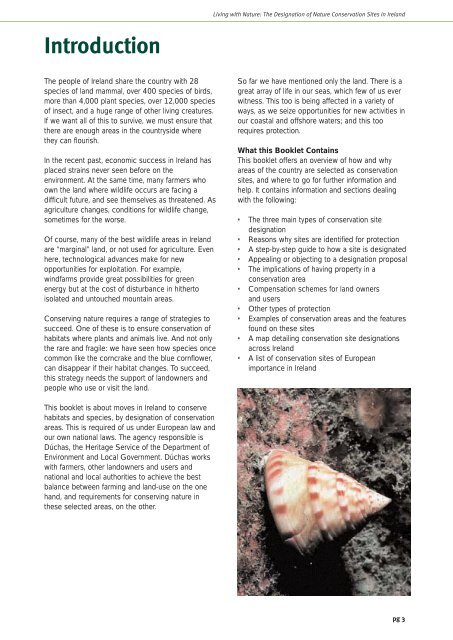The Designation of Nature Conservation Sites in Ireland
The Designation of Nature Conservation Sites in Ireland
The Designation of Nature Conservation Sites in Ireland
You also want an ePaper? Increase the reach of your titles
YUMPU automatically turns print PDFs into web optimized ePapers that Google loves.
Liv<strong>in</strong>g with <strong>Nature</strong>: <strong>The</strong> <strong>Designation</strong> <strong>of</strong> <strong>Nature</strong> <strong>Conservation</strong> <strong>Sites</strong> <strong>in</strong> <strong>Ireland</strong><br />
Introduction<br />
<strong>The</strong> people <strong>of</strong> <strong>Ireland</strong> share the country with 28<br />
species <strong>of</strong> land mammal, over 400 species <strong>of</strong> birds,<br />
more than 4,000 plant species, over 12,000 species<br />
<strong>of</strong> <strong>in</strong>sect, and a huge range <strong>of</strong> other liv<strong>in</strong>g creatures.<br />
If we want all <strong>of</strong> this to survive, we must ensure that<br />
there are enough areas <strong>in</strong> the countryside where<br />
they can flourish.<br />
In the recent past, economic success <strong>in</strong> <strong>Ireland</strong> has<br />
placed stra<strong>in</strong>s never seen before on the<br />
environment. At the same time, many farmers who<br />
own the land where wildlife occurs are fac<strong>in</strong>g a<br />
difficult future, and see themselves as threatened. As<br />
agriculture changes, conditions for wildlife change,<br />
sometimes for the worse.<br />
Of course, many <strong>of</strong> the best wildlife areas <strong>in</strong> <strong>Ireland</strong><br />
are “marg<strong>in</strong>al” land, or not used for agriculture. Even<br />
here, technological advances make for new<br />
opportunities for exploitation. For example,<br />
w<strong>in</strong>dfarms provide great possibilities for green<br />
energy but at the cost <strong>of</strong> disturbance <strong>in</strong> hitherto<br />
isolated and untouched mounta<strong>in</strong> areas.<br />
Conserv<strong>in</strong>g nature requires a range <strong>of</strong> strategies to<br />
succeed. One <strong>of</strong> these is to ensure conservation <strong>of</strong><br />
habitats where plants and animals live. And not only<br />
the rare and fragile: we have seen how species once<br />
common like the corncrake and the blue cornflower,<br />
can disappear if their habitat changes. To succeed,<br />
this strategy needs the support <strong>of</strong> landowners and<br />
people who use or visit the land.<br />
So far we have mentioned only the land. <strong>The</strong>re is a<br />
great array <strong>of</strong> life <strong>in</strong> our seas, which few <strong>of</strong> us ever<br />
witness. This too is be<strong>in</strong>g affected <strong>in</strong> a variety <strong>of</strong><br />
ways, as we seize opportunities for new activities <strong>in</strong><br />
our coastal and <strong>of</strong>fshore waters; and this too<br />
requires protection.<br />
What this Booklet Conta<strong>in</strong>s<br />
This booklet <strong>of</strong>fers an overview <strong>of</strong> how and why<br />
areas <strong>of</strong> the country are selected as conservation<br />
sites, and where to go for further <strong>in</strong>formation and<br />
help. It conta<strong>in</strong>s <strong>in</strong>formation and sections deal<strong>in</strong>g<br />
with the follow<strong>in</strong>g:<br />
• <strong>The</strong> three ma<strong>in</strong> types <strong>of</strong> conservation site<br />
designation<br />
• Reasons why sites are identified for protection<br />
• A step-by-step guide to how a site is designated<br />
• Appeal<strong>in</strong>g or object<strong>in</strong>g to a designation proposal<br />
• <strong>The</strong> implications <strong>of</strong> hav<strong>in</strong>g property <strong>in</strong> a<br />
conservation area<br />
• Compensation schemes for land owners<br />
and users<br />
• Other types <strong>of</strong> protection<br />
• Examples <strong>of</strong> conservation areas and the features<br />
found on these sites<br />
• A map detail<strong>in</strong>g conservation site designations<br />
across <strong>Ireland</strong><br />
• A list <strong>of</strong> conservation sites <strong>of</strong> European<br />
importance <strong>in</strong> <strong>Ireland</strong><br />
This booklet is about moves <strong>in</strong> <strong>Ireland</strong> to conserve<br />
habitats and species, by designation <strong>of</strong> conservation<br />
areas. This is required <strong>of</strong> us under European law and<br />
our own national laws. <strong>The</strong> agency responsible is<br />
Dúchas, the Heritage Service <strong>of</strong> the Department <strong>of</strong><br />
Environment and Local Government. Dúchas works<br />
with farmers, other landowners and users and<br />
national and local authorities to achieve the best<br />
balance between farm<strong>in</strong>g and land-use on the one<br />
hand, and requirements for conserv<strong>in</strong>g nature <strong>in</strong><br />
these selected areas, on the other.<br />
pg 3
















